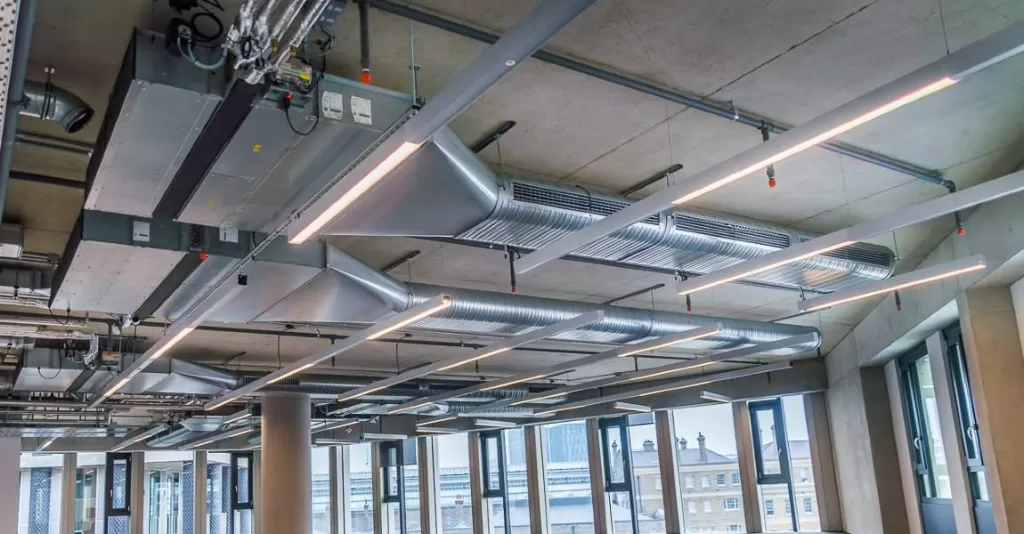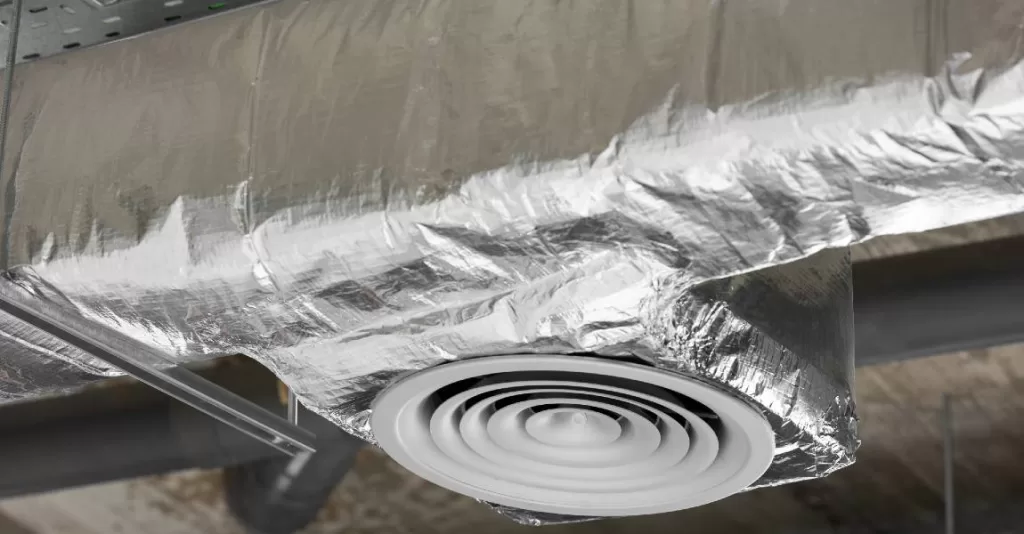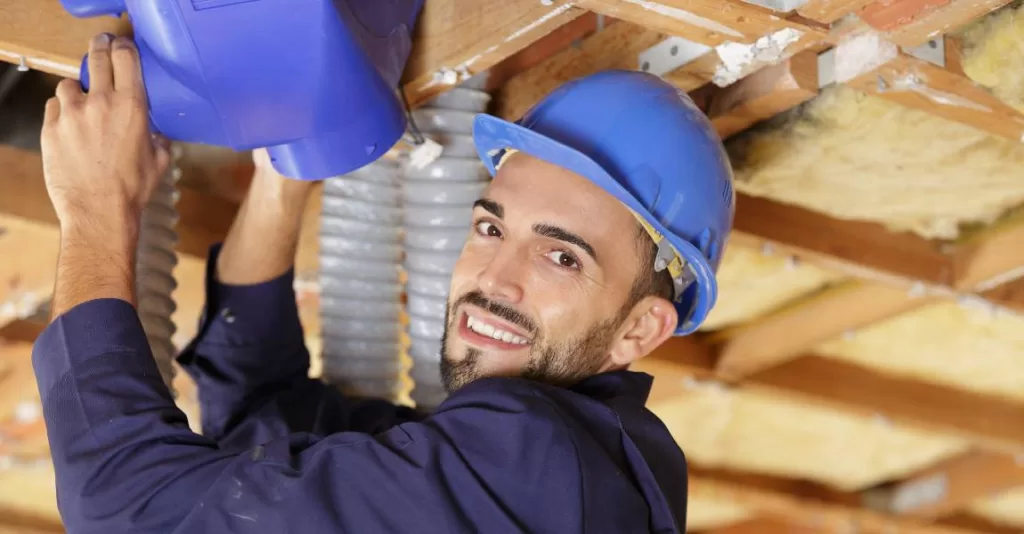Are you experiencing higher energy bills and inconsistent temperatures in your home? You may be asking How Do I Know if my AC Ducts are Leaking? Your AC ducts may be the culprit. Leaks in your ductwork can lead to wasted energy and poor air quality.
Identifying if your AC ducts have leaks is essential for maintaining a comfortable and energy-efficient home.
In this blog post, we will discuss common signs of ductwork leaks and provide tips on how to check for leaks yourself. By addressing leaks, you can save money on your energy bills and improve the performance of your air conditioning system. So, How Do I Know if my AC Ducts are Leaking?

- What Are Ducts?
- Why Should I Care About Leaky Ducts?
- Common Signs of Leaky Ducts
- Uneven Heating or Cooling
- Unconditioned Spaces in Home
- High Energy Costs
- Poor Indoor Air Quality
- How to Check for Leaks in Your Duct System
- Detecting an Air Leak:
- What to do if you have a Leaky Air Duct System:
- Air Duct Inspection
- Conclusion
What Are Ducts?
Air ducts are crucial to a building’s heating, ventilation and air conditioning (HVAC) system. They are responsible for distributing conditioned air throughout the building, ensuring every room receives a consistent warm or cool airflow.
Air ducts are typically made of sheet metal and are designed to be airtight to prevent any leakage or loss of conditioned air. They are installed behind walls, ceilings, or under floors, connecting the HVAC unit to various registers or vents throughout the building.
The primary purpose of air ducts is to transport air from the HVAC unit to different building areas. A fan or blower pushes or pulls The conditioned air through the ducts, ensuring each room receives the desired temperature.
They can also be used for ventilation, removing stale air, and introducing fresh air into the building.
In addition to air distribution, ductwork play a role in air filtration. Air filters are often installed in the ductwork System to remove dust, allergens and other particles from the air before circulating throughout the building or home.
They are essential for maintaining a comfortable and healthy indoor environment.
Why Should I Care About Leaky Ducts?
Why should you care about leaky ducts? Air duct leaks can significantly reduce the energy efficiency of your HVAC system, resulting in higher energy bills.
A leaky ductwork system can cause the conditioned air to escape into spaces behind walls or under floors, where it will be wasted instead of reaching the intended area. Leaks in the network of ducts also allow unconditioned air from outside.

Common Signs of Leaky Ducts
If your air ducts leak; You may notice some telltale signs, such as higher energy bills, inconsistent temperatures in different rooms and excessive dust accumulation.
Here are some common signs that may indicate a leaky duct system:
Unusually high energy bills: Basically if your energy bills have been steadily increasing, but you haven’t made any significant changes to your lifestyle, you may have a leaky duct system.
Inconsistent temperatures: When some rooms are consistently warmer or cooler than others, it could be due to air leakage in the ducts.
Poor indoor air quality: A leaky duct system can also lead to poor indoor air quality as outside air is drawn in and circulated throughout the building. This can result in excessive dust or allergens in the air.
• Visible damage: If you can visibly see cracks, holes, or other damage to your ducts, you likely leak.
Uneven Heating or Cooling
Uneven heating or cooling in your home can indicate that your AC ducts are leaking. When leaks in your air ducts, the conditioned air can escape before it reaches its intended destination, causing uneven temperatures throughout your home. This can be especially noticeable if certain rooms are consistently warmer or cooler than others.
If you notice that your energy bills have been higher than usual, it could result from air duct leaks.
To determine if your Air conditioner ducts are leaking; you can perform a simple test using a smoke pencil. Turn on your HVAC system and hold the smoke pencil near the duct joints and connections. If you see the smoke being pulled into the duct joints or blowing out of the ducts indicates leaks.
Another sign of a leak is if you feel air escaping from the ducts or notice any visible damage, such as holes or tears.
If you suspect your AC ducts are leaking, it is essential to address the issue promptly to prevent further energy loss and discomfort in your home.
Duct repair is typically the most effective solution for fixing leaks in HVAC ducts. This involves sealing the leaks using specialized materials and techniques.
Professional repair services can help identify and seal any leaks in your AC ducts, ensuring that your HVAC system operates efficiently and effectively.
The Environmental Protection Agency estimates that sealing and insulating ducts can improve the efficiency of your heating and cooling system by up to 20%.
Unconditioned Spaces in Home
Unconditioned spaces in a home refer to areas not heated or cooled by the HVAC system.
These spaces may include:
- attics
- crawl spaces
- unfinished basements
- enclosed patios
One common issue with unconditioned spaces is that they can contribute to air leakage, resulting in energy loss and discomfort in the home. When AC ducts leak in these unconditioned spaces, it can exacerbate the problem.
Leaky AC ducts allow conditioned air to escape into unconditioned areas, leading to inefficient cooling and increased energy bills. To determine if you have a leak, you can perform a visual inspection or hire a professional HVAC technician.
Key Takeaway:
Signs of leaking ducts may include uneven cooling or heating, high energy bills, excessive dust accumulation, or hot or cold spots in certain areas of the home.

High Energy Costs
High energy costs can be a significant concern for homeowners, especially regarding utility bills.
One common cause of high energy costs is leaking AC ducts. When your AC ducts leak, the cool air produced by your air conditioner escapes through the leaks, causing your AC to work harder and use more energy to cool your home. This can result in higher monthly utility bills as your AC system struggles to maintain the desired temperature.
If you notice a sudden increase in your utility bill or your AC system is constantly running without effectively cooling your home, it may be a sign that your AC ducts are leaking and needing repair.
According to the U.S. Department of Energy, up to 30% of heated or cooled air can be lost through leaks in air ducts. This can result in higher energy bills and reduced comfort in your home.
Poor Indoor Air Quality
The poor indoor air quality can significantly impact our health and well-being. Futhermore, if AC ducts are leaking, it can contribute to the presence of air pollutants in our homes.
These pollutants include:
- dust
- pollen
- mold spores
- pet dander
- volatile organic compounds (VOCs)
Breathing in these contaminants can lead to respiratory issues, allergies, asthma attacks, and other health problems.
It is important to promptly address any obvious leaks to improve indoor air quality and create a healthier living environment for ourselves and our families.
How to Check for Leaks in Your Duct System
To check for leaks in your ductwork system, perform a visual inspection or use specialized equipment such as a fog machine.
You can start by looking at your ducts for any visible signs of leaks, such as loose or disconnected sections, gaps, or cracks. You can also use a grease pencil to mark any suspected areas.
Alternatively, a fog machine can blow non-toxic smoke into the ducts, revealing any leaks as the smoke escapes through them.
Furthermore, this type of method is particularly effective in identifying small or hidden leaks.
By identifying and repairing any leaks in your system, you can improve the efficiency of your HVAC system and reduce energy waste.
Detecting an Air Leak:
- Use a smoke pencil test to determine if there are leaks in your AC ducts.
- Look for smoke being pulled into the duct joints or blowing out of the ducts.
- Feel for air escaping from the ducts or check for visible damage, such as holes or tears.
What to do if you have a Leaky Air Duct System:
- Promptly address ductwork leakage to prevent energy loss and discomfort in your home.
- Duct repair is the most effective solution for fixing leaks in HVAC ducts.
- Professional repair services can identify and seal any leaks in your AC ductwork.

Air Duct Inspection
Air duct inspection assesses the condition and functionality of the air duct systems in a building.
Here are some reasons why air duct inspection is essential:
Indoor air quality:
The air duct system is crucial in circulating air throughout a building. Over time, dust; dirt, allergens, and other contaminants can accumulate in the ducts. Regular inspection helps identify any issues with cleanliness and air quality, allowing for appropriate cleaning or maintenance measures to be taken.
Energy efficiency:
A poorly maintained or malfunctioning air duct system can result in energy wastage. Leaks, blockages, or improper insulation can cause air loss, leading to increased energy consumption and higher utility bills. Inspection helps identify any inefficiencies and allows for necessary repairs or improvements to be made, ensuring optimal energy efficiency.
Health and safety:
Dirty or contaminated air ducts can contribute to poor indoor air quality, leading to respiratory issues, allergies, and other health problems.
Additional Health and Safety Issues:
- mold growth
- pest infestations
- the presence of harmful substances
Regular inspection helps detect these issues early on, allowing for appropriate remediation to ensure a safe and healthy environment.
Equipment lifespan:
Properly maintained systems can extend the lifespan of HVAC equipment. Regular inspection helps identify any issues or malfunctions that may strain the system excessively, allowing for timely repairs or replacements. This can help avoid costly breakdowns and premature equipment failure.
Compliance with regulations:
In specific industries or buildings, such as healthcare facilities or commercial kitchens; there may be specific regulations or standards regarding air quality and ventilation. Regular air duct inspection ensures compliance with these regulations, avoiding potential penalties or legal issues.
Improved system performance:
A well-maintained air system operates more efficiently. It provides better airflow, temperature control, and overall comfort. Inspection helps identify any issues that may be affecting system performance, allowing for appropriate adjustments or repairs to optimize performance.
Cost savings:
Air duct inspection can help prevent costly repairs or replacements by identifying and addressing any issues early on. Also, it contributes to energy saving by ensuring optimal system performance. This will reduce energy wastage.
An Air duct inspection is essential for maintaining a healthy, comfortable, and energy-efficient indoor environment. Regular inspections and maintenance can help prevent potential problems, improve air quality, and extend the lifespan of HVAC equipment.
The American Society of Heating, Refrigerating and Air-Conditioning Engineers (ASHRAE) recommends having your air ducts inspected for leaks every 3-5 years to ensure optimal performance and energy efficiency.
Conclusion
In conclusion, if you suspect that your AC ducts are leaking, there are a few signs to look out for reduced airflow, increased energy bills, and inconsistent temperatures throughout your home.
It is crucial to address these issues promptly to ensure the efficiency and effectiveness of your AC system.
Contact a professional HVAC technician today to schedule a service and have your AC ducts inspected and repaired.
Don’t wait until the problem worsens and results in costly repairs. Take action now and enjoy a comfortable and energy-efficient home.





